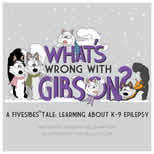Epilepsy and the Greater Swiss Mountain Dog


![]()
First published in the Jan 2004 issue of the AKC Gazette reproduced with permission from the author
Karen Conant
Several serious heritable diseases may affect the Greater Swiss Mountain Dog and pose significant risk to the future health of our breed. Those of greatest concern are epilepsy, bloat, splenic torsion, and hip dysplasia. There are many factors related to epilepsy that make it a disease of great concern for Swissy fanciers.
The median age of death from bloat and splenic torsion in the GSMD is 9 years of age, largely due to available surgical options and treatment. However, the median age of death from epilepsy in the Swissy is 3.75 years. Though canine idiopathic epilepsy commonly develops after two years of age, the onset in Swissys may be much later. A late onset disease is of special concern to breeders, as a dog or bitch may be bred several times before being identified as a carrier or possibly even an affected animal. Unfortunately, there are no tests to determine if a Swissy carries these genes until it develops the disease, produces affected offspring, or until a parent develops the disease.
From an owner's perspective, epilepsy is an extremely challenging disease to manage. Oftentimes, Swissys do not respond well to drug therapy and continue to experience seizures and fatalities despite increasing medications. These medications have a high degree of toxicity and side effects, and require dogs to be carefully and continuously monitored. Management of an epileptic dog often severely impacts the lifestyle of the owner.
Canine genetics researcher, Dr. George Padgett, recently analyzed our health survey data and concluded that at least 39% of GSMDs carry the genes to produce epilepsy. A high priority must be placed on reducing this carrier rate in our breed. Sadly, even the most concerned breeder can produce puppies that develop epilepsy. Those who reveal cases of the disease and strive to eliminate carriers demonstrate a very high degree of ethical breeding.
Many matings carry an inherent risk to produce epilepsy. Those risks can be reduced if breeders utilize information about epilepsy in the relatives of prospective mates, and remove all known carriers from the breeding population. Offspring of affected dogs should not be bred, and care should be taken in selecting mates at low risk for carrying the genes for the disease. Healthy dogs known to have affected relatives should only be bred to dogs with good depth of normalcy in the pedigree. Making education on epilepsy a high priority is another key element in our effort to reduce this disease. Maintaining contact with homes and reporting cases of epilepsy to owners of littermates could positively affect future breeding decisions.
The GSMDCA stands committed to supporting research on epilepsy. Our members have submitted an impressive number of samples (over 650) to the University of Missouri Epilepsy Research Project. Through our AKC Canine Health Foundation Donor Advised Fund for the GSMD, our club has directed funds toward this project to search for genes causing this disease, as well as identifying modes of inheritance and seizure types. The GSMDCA has also received permission from the Canine Health Information Center (CHIC) to add veterinarian certified reported cases of epilepsy to our CHIC database for the Swissy. In addition, our club maintains a health database that will hopefully soon begin to list dogs affected with epilepsy. These projects are a result of the outstanding commitment of our Health Committee and members of the GSMDCA.
Page last update: 05/30/2011










